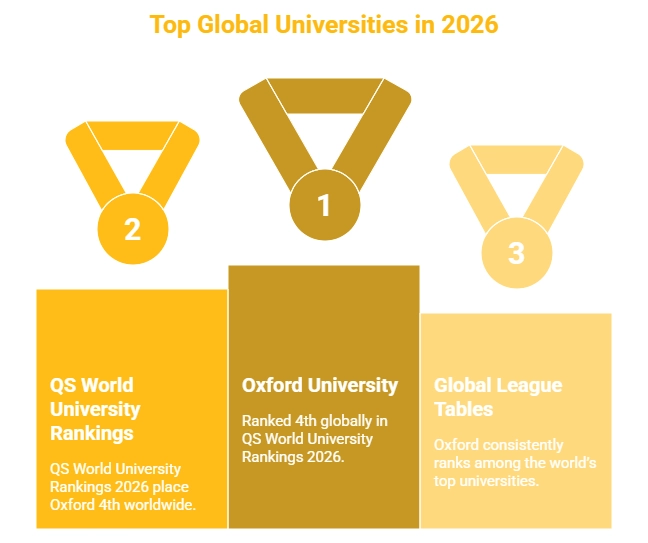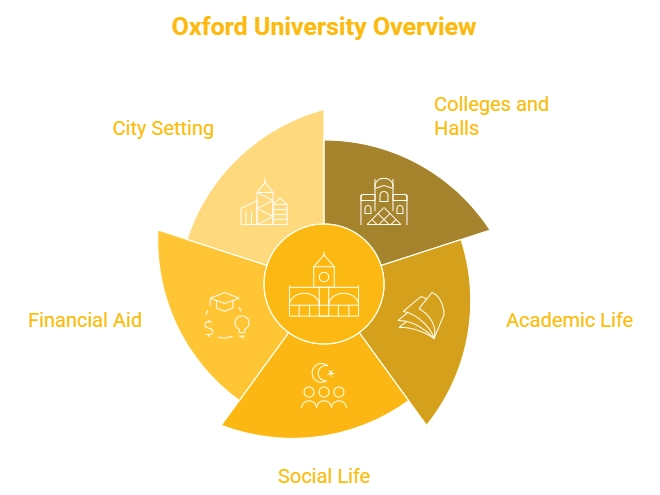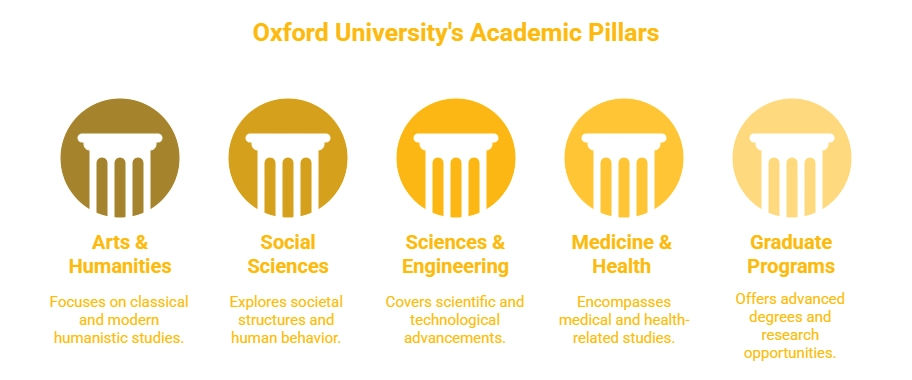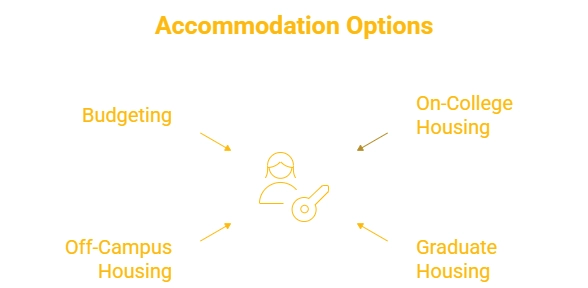Selecting a university involves considering its prestige, how it can help your career, and the overall student life it offers. Oxford provides top-notch teaching and research, a long-standing college system, and a good history of getting graduates into jobs. It often ranks high globally, draws students internationally, and gives great access to resources like libraries, museums, research centres, and industry connections.
Why This Information Matters for UK Applicants:
Oxford is consistently one of the world’s top universities in global league tables. The QS World University Rankings for 2026 place Oxford 4th worldwide, based on its academic and employer standing, research influence, and international perspective.
Understanding Rankings:
Different ranking systems use different approaches. QS emphasizes academic and employer surveys plus citations per faculty member. THE (Times Higher Education) puts more weight on teaching, research, citations, and international factors. Oxford does well in many areas, which explains its consistent high ranking in most major tables.
Advice for Applicants:
Rankings show worldwide recognition, but applicants should also consider a department's standing, fit within a college, and teaching style when picking a course. Focus on subject-specific rankings, not just the overall rank, when deciding what to study.

Oxford admissions are competitive, and the standards change based on the course.
Course-Level Differences
How Oxford Evaluates Applicants
Oxford is a collegiate university, not a multi-campus one. Its teaching and research are based in the city of Oxford, and the college system is key to the student experience.
Colleges and Halls: Oxford has 36 colleges, three societies, and four permanent private halls. Each college is self-governing and offers housing, tutorials, support, and social events. Students join both a college and the university.
Why colleges matter: Colleges host many tutorials (small-group teaching sessions). They influence your academic and social life and often offer financial aid and scholarships. Colleges differ in size, housing, facilities, and traditions. Many applicants state college choices, while others ask for open assignment.
City setting and facilities: Oxford has many libraries (like the Bodleian), museums (like the Ashmolean), research centers, and ties to industry and culture. It is close to London and Europe for internships, conferences, and trips.

Oxford has four divisions that provide different programs for graduates and undergraduates: Humanities, Mathematical, Physical & Life Sciences, Medical Sciences, and Social Sciences.
Typical undergraduate courses:
Graduate programs:
Master's degrees, research degrees, professional doctorates, and DPhils (PhDs) are offered in many subjects. A lot of departments have master's programs such as an MSc in Computer Science, or an MSc in Evidence-Based Social Intervention.

Things to know:
Choosing a course:
Carefully read course pages to understand the structure, requirements such as a year abroad, how the course is graded, and admission test needs. If you can, go to open days and sample lectures.
Here's a brief table showing typical fee ranges and major scholarship programs. Keep in mind that fees differ by course and are updated each year. Always check the Oxford course page for the most current information.
| Student Group | Typical Course Fees (per Year) | Typical Living Costs (per Year) | Major Scholarship Examples |
| Home (UK) undergraduates | £9,535 (2025/26 guidance; subject to government cap — check latest) | £17,100–£24,420 (estimated living costs per year; colleges can reduce some costs) | Oxford bursaries, college hardship funds |
| Overseas (international) undergraduates | £35,000–£58,000 (typical range depending on course — e.g., humanities at lower end; clinical and laboratory-intensive courses at higher end) | £17,100–£24,420 (same living cost guidance applies) | Oxford International Scholarships, Reach Oxford Scholarship |
| Postgraduate (UK/home) | £10,000–£45,000+ (wide range depending on master’s or research programme) | £17,100–£24,420 (varies by course length and personal spending) | Clarendon Scholarships (fully funded), UK Research Council funding |
| Postgraduate (international) | £20,000–£50,000+ (many master’s programmes fall between £25k–£45k) | £17,100–£24,420 | Clarendon Scholarships (fully funded), college scholarships, departmental studentships |
Colleges are very involved in housing students, mostly first-year undergraduates.
On-college housing
• Most colleges make sure that first-year undergraduates have housing, often in college rooms with shared or private bathrooms. Colleges usually provide food or kitchens.
Graduate housing
• Many colleges also have rooms or apartments for graduate students, but it depends. The Graduate Housing Service and college websites have lists and waiting lists.
Off-campus housing
• There are private rentals and student housing all over the city. Prices change based on location and type (shared flat or studio). Plan for rent, council tax (if needed), utilities, and council deposits.
Budgeting
• Colleges sometimes lower the cost of meals, events, and facilities, which lowers living costs. Apply for college housing early and check the college housing pages for prices and contract lengths.

Here’s a guide for UK applicants, and international applicants from a UK point of view, for both undergraduate and graduate study.
Step 1: Carefully read the course page for required subjects, admission tests (like BMAT, LNAT, MAT), and the typical A-level/IB grades needed.
Step 2: Sign up for tests early. Test dates vary, with some in the fall, so check when your test is.
Step 3: Oxford wants UCAS applications earlier than many UK universities. Check the specific date for the current year. Applications include your personal statement, predicted or achieved grades, and a reference.
Step 4: Some courses need writing samples or portfolios, such as English or History of Art. Follow the department's guidance closely.
Step 5: Applicants who make the shortlist get invited to interviews, either in person or online. Interviews check your subject knowledge, thinking, and potential, not just what you already know.
Step 6: Offers can depend on grades (like A\*AA) or be unconditional, based on your qualifications and situation. If you get an offer, use UCAS to accept, hold, or decline it.
Step 7: If you get a spot, apply for college housing and look into funding options like college support, central scholarships, and government loans if you can get them.
Step 1: See department pages for research ideas, supervisor availability, and specific must-haves.
Step 2: Expect to need academic transcripts, a CV, a research idea (for research degrees), references, and proof of English if it's needed.
Step 3: Deadlines change based on the course and funding. Many Clarendon scholarship candidates must apply by the December/January deadline to get looked at automatically.
Step 4: Apply for college/department scholarships and outside funding as early as you can. Clarendon looks at eligible applicants on its own.
Step 5: If accepted, follow the university's directions for signing up, visa help for overseas students, and college placement.
Australia Student Visa
Akshay applied for a Student visa for Au
Read More...
Australia Student Dependent Visa
Sameera applied for a Student visa for A
Read More...
Australia Student Visa
Prashanth Sikhamani came to us as he was
Read More...
Suppose you are not a native English speaker living in the UK or a Permanent Resident of a non-English speaking nation. In that case, you must take the English Language Test (ELT) in Australia as part of your student visa. There are several types of ELT in Australia; you need to choose the correct ELT specified by your university in Australia for the course you are pursuing. Below are the minimum scores required to score for ELTs in Australia.
| English Language Test | Minimum Overall Score |
| IELTS | 5.5 |
| TOEFL | 46 |
| CET | 162 |
| PTE | 42 |
| Occupational English Test | ‘B’ for each test component |
The following are the variations in work permissions and other related differentiations under the Australia Study Visa:-
| Categories of differentiation | Visa (Subclass 485) | Visa (Subclass 500) | Visa (Subclass 590) |
| Cost of Visa | AUD 1730 | AUD 650 | AUD 650 |
| Work Permissions While Studying | Study Visas after April 2008 automatically make you eligible to work:- -For unlimited hours when your course is not in session | ||
| Work Permit After Completing Education | Note that English Language Proficiency courses pursued by international students can’t be used to fulfill Australia Study Visa Requirement.
So these courses can’t be counted for Post Study Work Permit under sub-class 485 |
International student who complete Australian study requirement, are eligible to apply for Post-Study Work Permit under both subclasses. | |
| Exceptions (if any) | In case an international student has been asked to take an English language course as a forerunner to admission to a regular degree/diploma course, the international student must apply for a student visa that is eligible for the main course. | In case the course duration doesn’t match the Australian Study Visa Requirement, the international student can undertake 2 or more programs that will be added to check his/her eligibility for a Post Study Work Permit. | In case your visa expires before you complete your graduation, then as an you can apply for a visitor visa.
You need to provide a letter from your Australian university/ institute that states the upcoming date of your graduation in the course. |
| S. No. | Post-Study Work Visa | Key Features |
| 1. | Skilled-Recognised (Subclass 476) Graduate Visa | Applicable for Engineering graduates |
|
|
| Stay duration up to 18 months |
|
|
| Processing time 8 months to 11 months |
|
|
| Visa cost Starts from AUD 405 |
|
|
| Visa type Temporary |
|
|
| Allows you to bring the family with you |
| 2. | Temporary Graduate Visa (Subclass 485) for Graduate Work Stream | Applicable for recent graduates |
|
|
| Stay duration up to 18 months |
|
|
| Processing time 90 days to 4 months |
|
|
| Visa cost start from AUD 1650 |
|
|
| Visa type is temporary |
|
|
| Allows you to bring your family with you |
| 3. | Temporary Graduate Visa (Subclass 485) for Post-Study Work Stream | Recent graduates from an Australian institution can apply for this visa |
|
|
| Stay duration Between 2 and 4 years |
|
|
| Processing time 70 days to 90 days |
|
|
| Visa cost Starts from AUD 1650 |
|
|
| Visa type Temporary |
|
|
| Allows you to bring the family with you |
If you wish to pursue a Master’s degree in Australia, you can do it by choosing the right kind of subject, degree, and most importantly the university. It will help you enhance your technical skills and give your CV an edge over others.
As an international student from the UK having completed your graduation, you should look for a university where the emphasis is on practical learning, knowledge enhancement, and hands-on work experience. All these will help you become job-ready for the future. Universities in Australia provide you a chance to enhance research-based learning approaches that will allow you to implement any concepts or ideas that you may learn in your classroom.
You can start by looking at the subjects available for post-graduate studies that are in line with your graduation program. You can narrow down your preferred choices as per your academic scores by listing the most relevant ones. You can then look for universities and colleges offering programs covering your preferred subjects.
As a next step you apply to the Australian universities and institutions by taking the language and/or aptitude tests. Once you clear some of the most appropriate ones, it is then up to you to decide where to study. Where to study not only on the subjects you choose but also on fee structure, faculty, college environment, facilities, communication, and safety.
You must also consider which university allows you to work on or off campus to support yourself. After considering all the above choose which will be your preferred course at your preferred university and prepare accordingly.
Yes, your Australia international student visa can be rejected. However, the rejection rate for an international student visa is only between 4-8% in the last few years. If your student visa lacks any kind of information that could have bolstered your student visa claim by proving the claims you mentioned, there is a good chance that your Australian study visa will be rejected.
According to the new student visa rules, visa applicants must now submit a Confirmation of Enrolment (CoE) instead of a Letter of Offer. This change was effective January 2025 and applies to both onshore and offshore student visa applicants.
Some of the other student visa rules that were announced in 2025 are as follows: